Shopify Blogs: How To Build & 5 Examples To Inspire Your Brand
This tutorial will walk you through every step on how to build a blog on Shopify. We will cover everything from choosing a theme to writing engaging posts to promoting your blogs on social media. Let’s get started!
Is Shopify A Good Place to Blog?
Yes, Shopify can be an excellent place to blog, especially if you already have a Shopify store. It’s a perfect choice because it’s built-in, easy to use, and integrates seamlessly with your products. Here are some pros & cons to consider:
Pros
- Integration with ecommerce: If you run an online store, your blog product pages are vital. You can easily link to products from your blog posts and vice versa.
- SEO tools: Shopify offers various built-in SEO that help optimize your blog posts for search engines, improving your visibility and ranking
- Ease of use: Shopify’s user-friendly interface simplifies creating and managing blog content, making it accessible even to those without technical skills.
- Customized themes: You can customize numerous available themes to align with your brand’s aesthetic, improving the overall customer experience.
- App integrations: Shopify’s extensive app store includes many blogging tools and plugins to improve your blog’s functionality, such as social media sharing, email marketing, and analytics.
Cons
- Limited Blogging Features: Unlike dedicated blogging platforms like WordPress, Shopify’s blogging features are limited.
- Cost: While Shopify’s plans are reasonably priced for e-commerce, they might be expensive if you are primarily focused on blogging.
- Control and Flexibility: Shopify’s primary focus is e-commerce, so some blogging features might not be as robust or customizable as those on platforms explicitly designed for blogging.
How to Create a Successful Shopify Blog
If you are a Shopify store owner seeking to diversify into blogging, creating a blog for Shopify is more straightforward than you think. Let’s dive into how to add a blog to Shopify right now!
Step 1: Log in to Shopify Account
- Log into your Shopify Admin account.
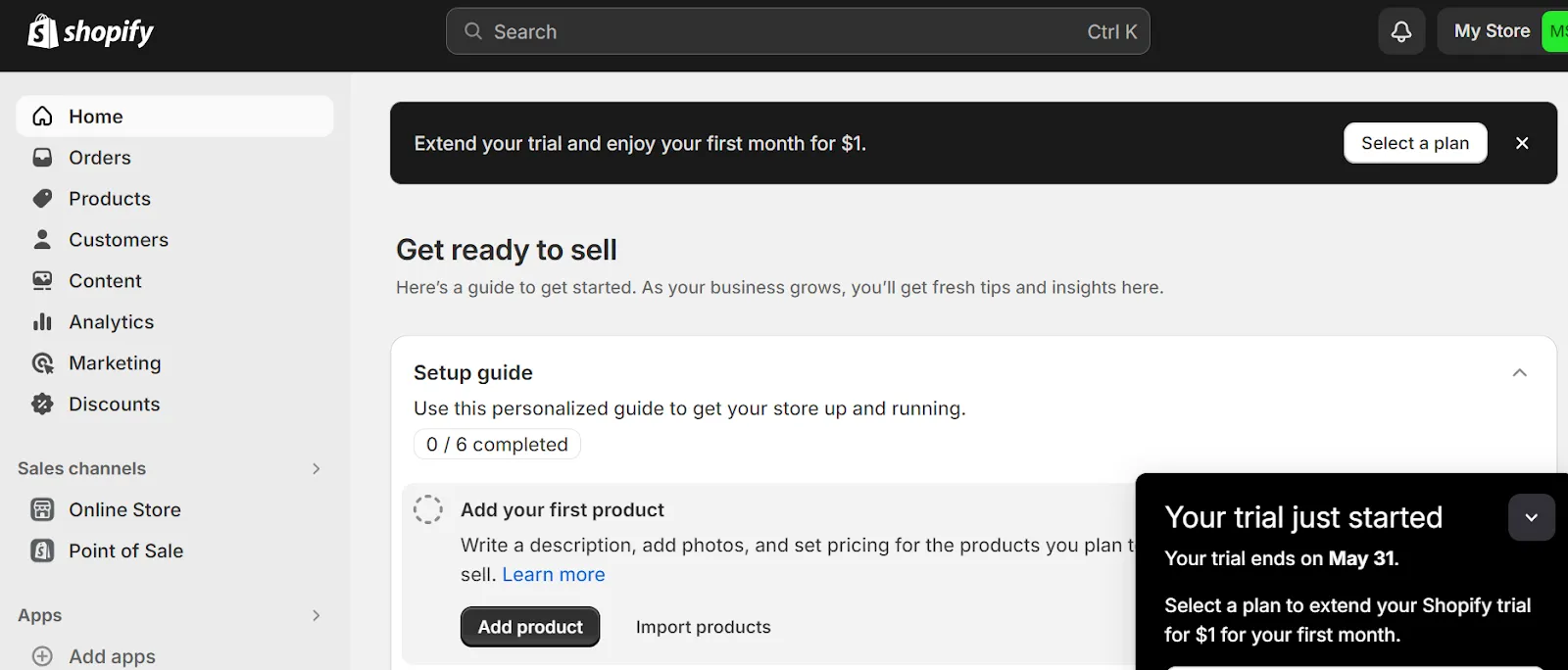
Step 2: Access the Blog Creation Tool
- In your Shopify admin panel, click “Online store” and choose “Blog posts.”
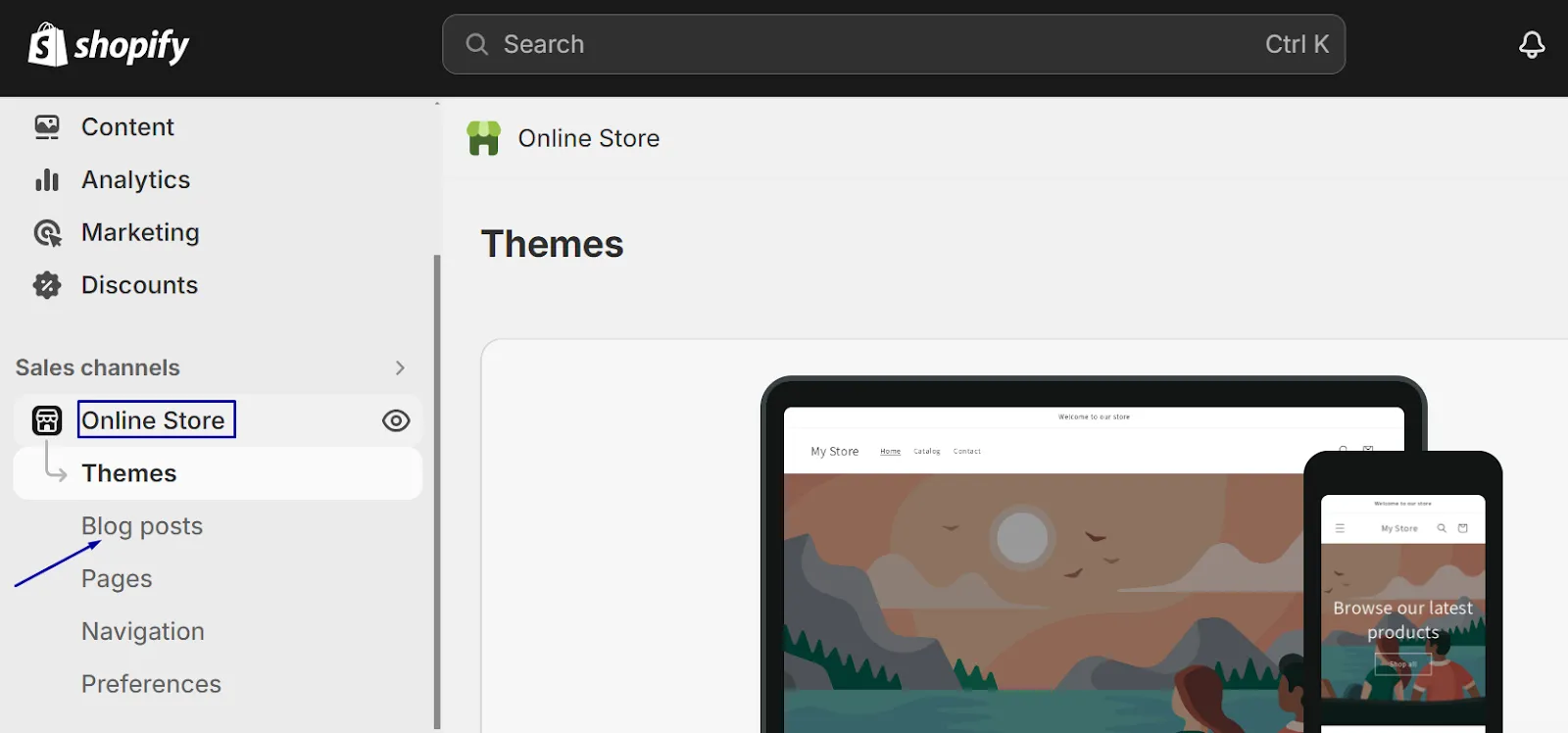
- As you can see, I don’t have an active blog. Click the “Create blog post” button to start creating one.
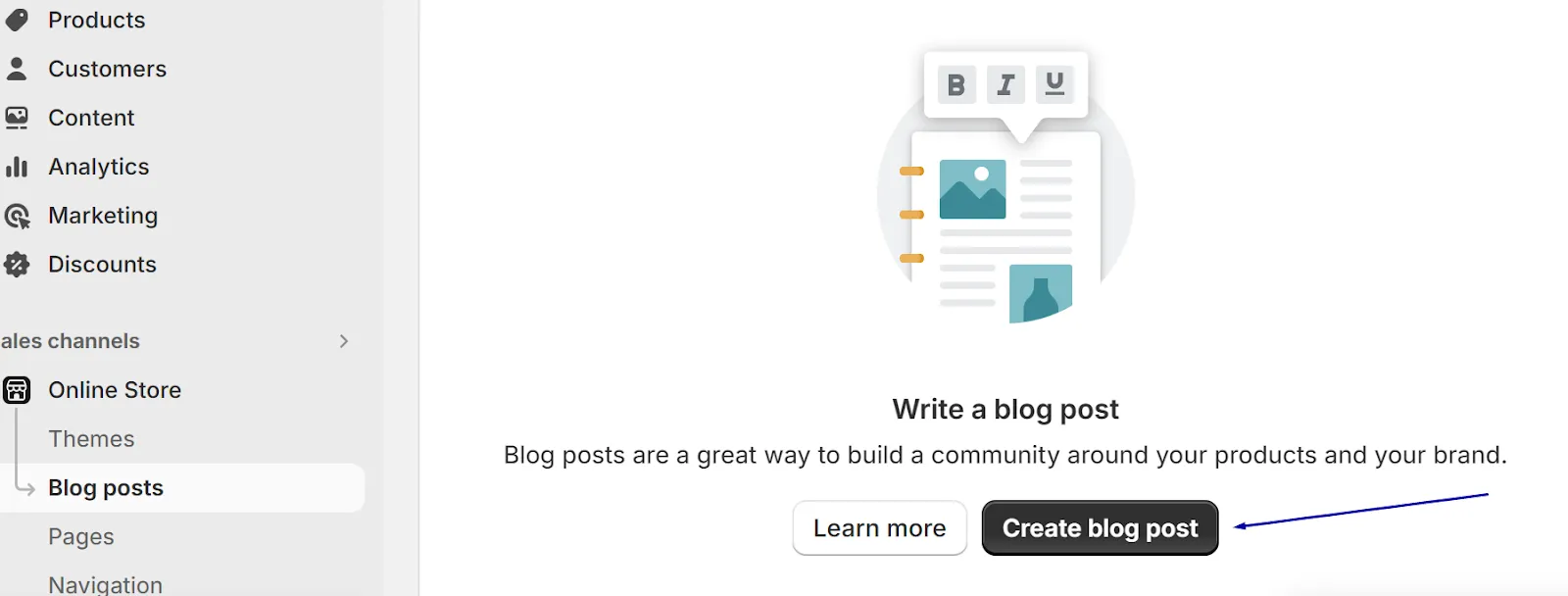
Step 3: Create your Content
So, this is Shopify’s blog post. Here, you start writing your blog.
1. Enter your blog title: Your headline is your first chance to grab attention, so make it relevant and compelling. Consider using numbers (e.g., 5 Ways to boost your “Shopify sales”) or strong adjectives (e.g., “The Ultimate Guide to Shopify Marketing”).
2. Write your content: Break up your text with images, subheadings, and bullet points in a conversational and friendly tone.

3. Choose an author for your blog post: This could be your name, your brand name, or a guest contributor’s name.
4. The category for your blog to appear in: Categorize your blog post to help readers find content that interests them. Use broad categories (e.g., “News,” “Tips & Tricks”) and create subcategories for more specific topics (e.g., “Email Marketing,” “Product Reviews,” “Customer Success Stories”).
5. Tags related to your blog post: Tags are like keywords that describe your post, so you need to use relevant and specific tags, such as “Shopify SEO,” “Shopify Themes,” or “Shopify: Tips & Tricks.”
6. Set “Default blog post”: This option makes the post the main featured article on your blog’s homepage.
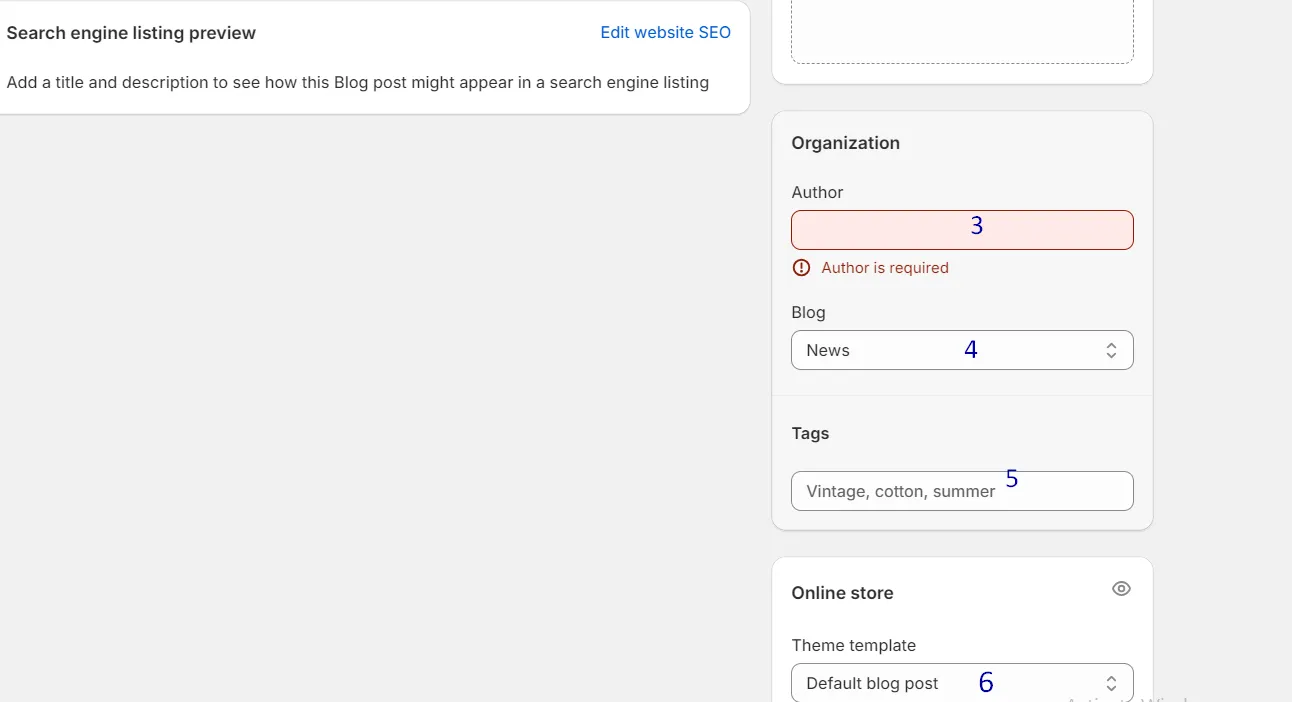
7. After that, click the “Save” button. Now, your blog post will be visible on your Shopify blog page.

Step 4: Add Images to Visualize
- Next, spice up your blog by adding images is vital. Add them by choosing the “Add image” button on the toolbar.
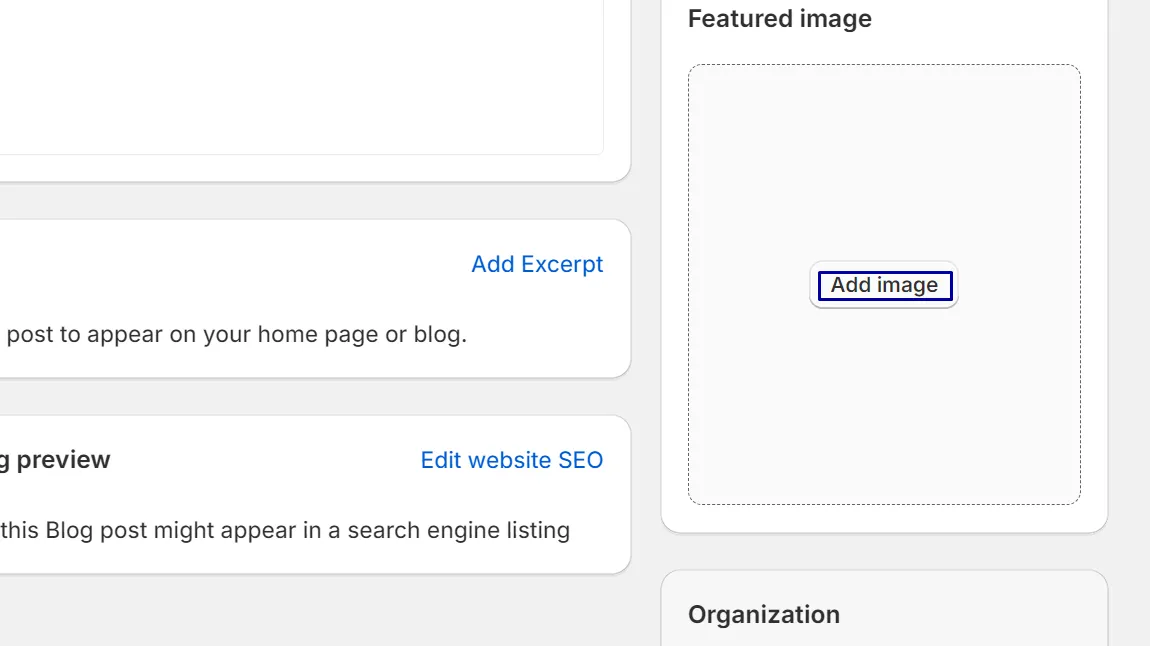
- Select and drag your files to the gallery to upload images to your Shopify media library by clicking the “Upload” button and “Done.”
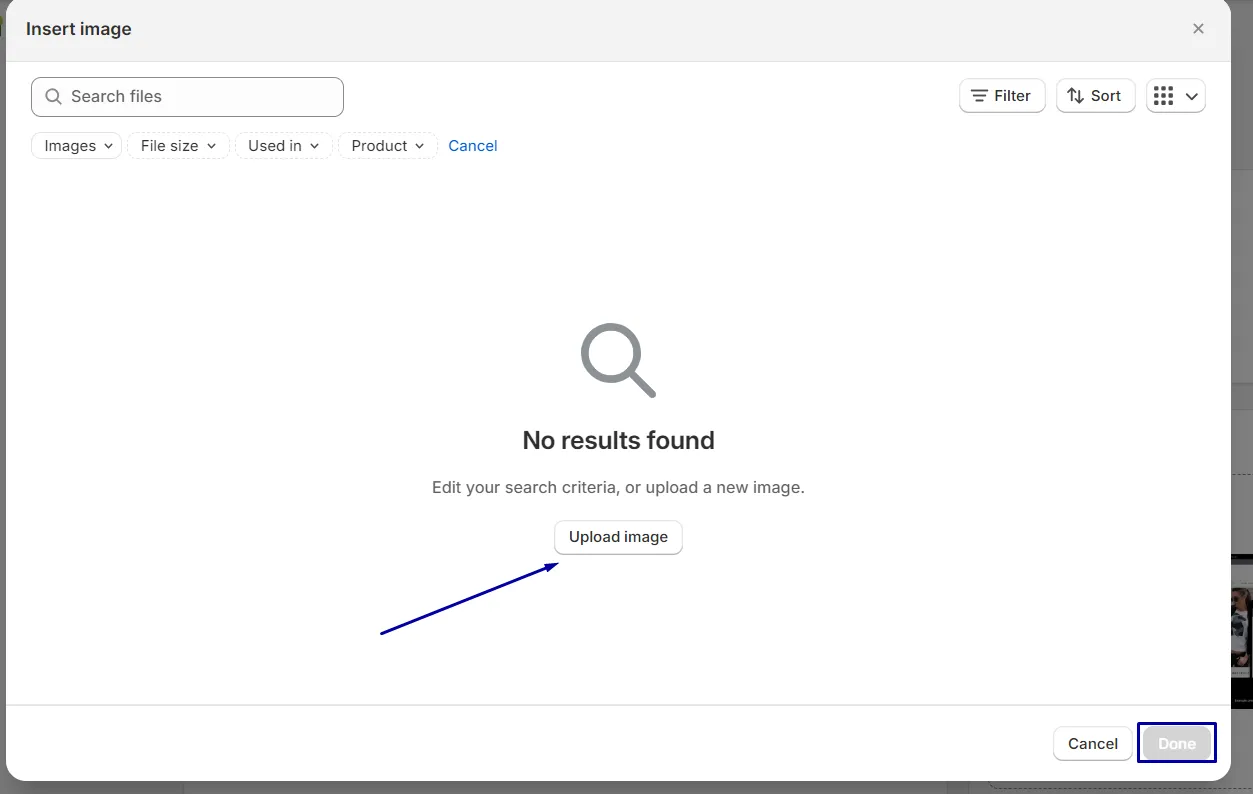
- After choosing the image you want, add “Image Alt text,” and click the “Save” button. ALT-text provides better context and description for search engine crawlers, helping them index the image properly.
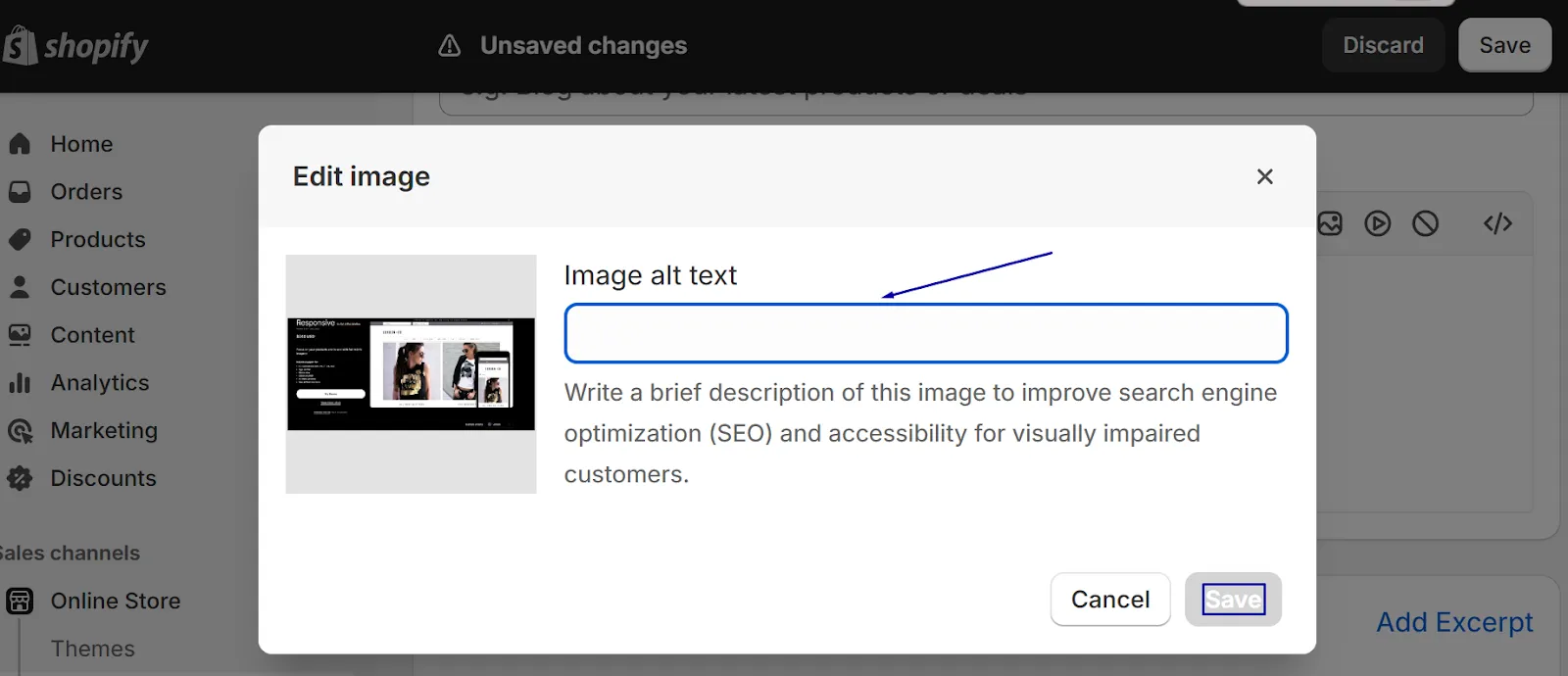
- Add “Featured Image” to your blog so readers can see if your blog is published on social media. Just “Drag and drop the image” you want to the section.
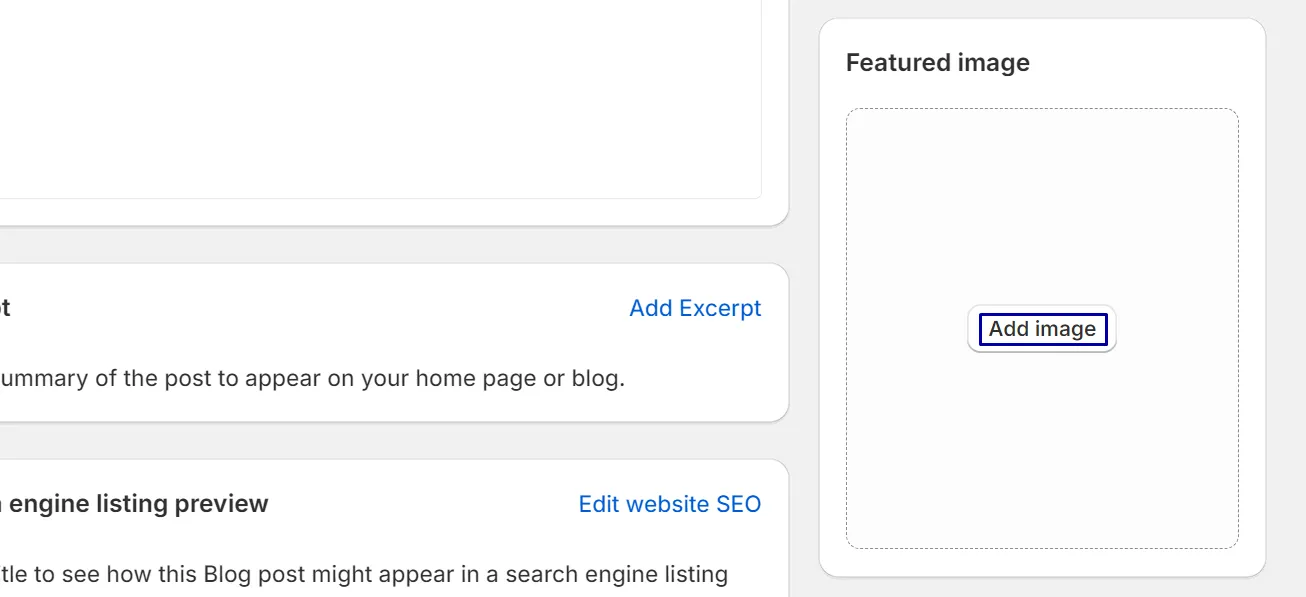
Step 5: Add Video to Your Blog Post
The next step is to add a video to your blog. You can return to your content field and choose the white space for your video. Then click the “…” button and select the “Video icon” on the toolbar.
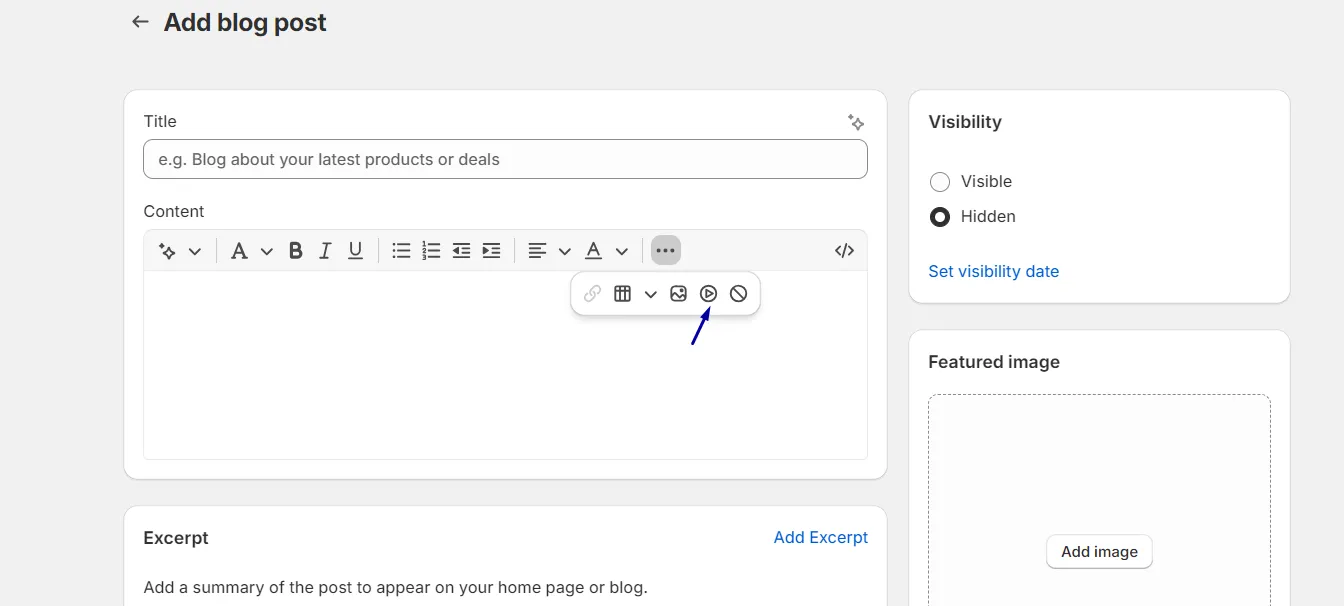
- A pop-up will appear for inserting an embed snippet, and click “Insert video.
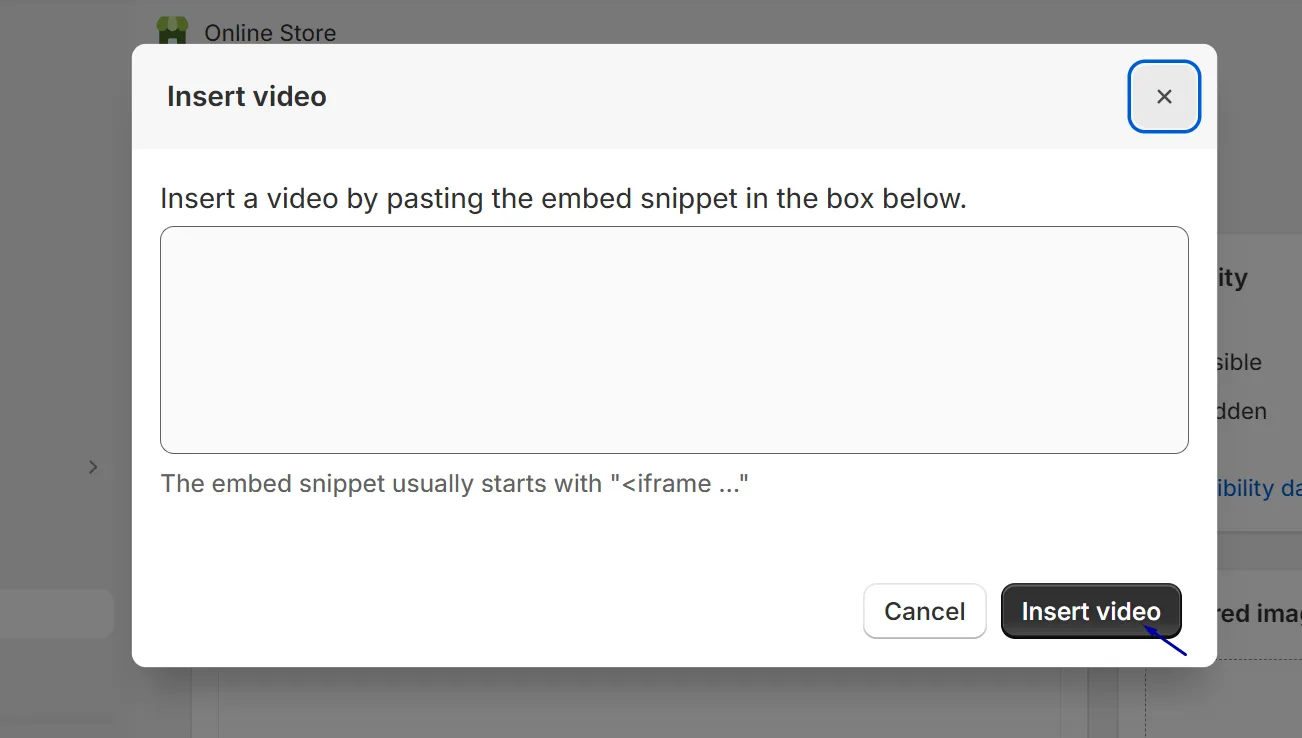
- You can see your video added to your blog post.
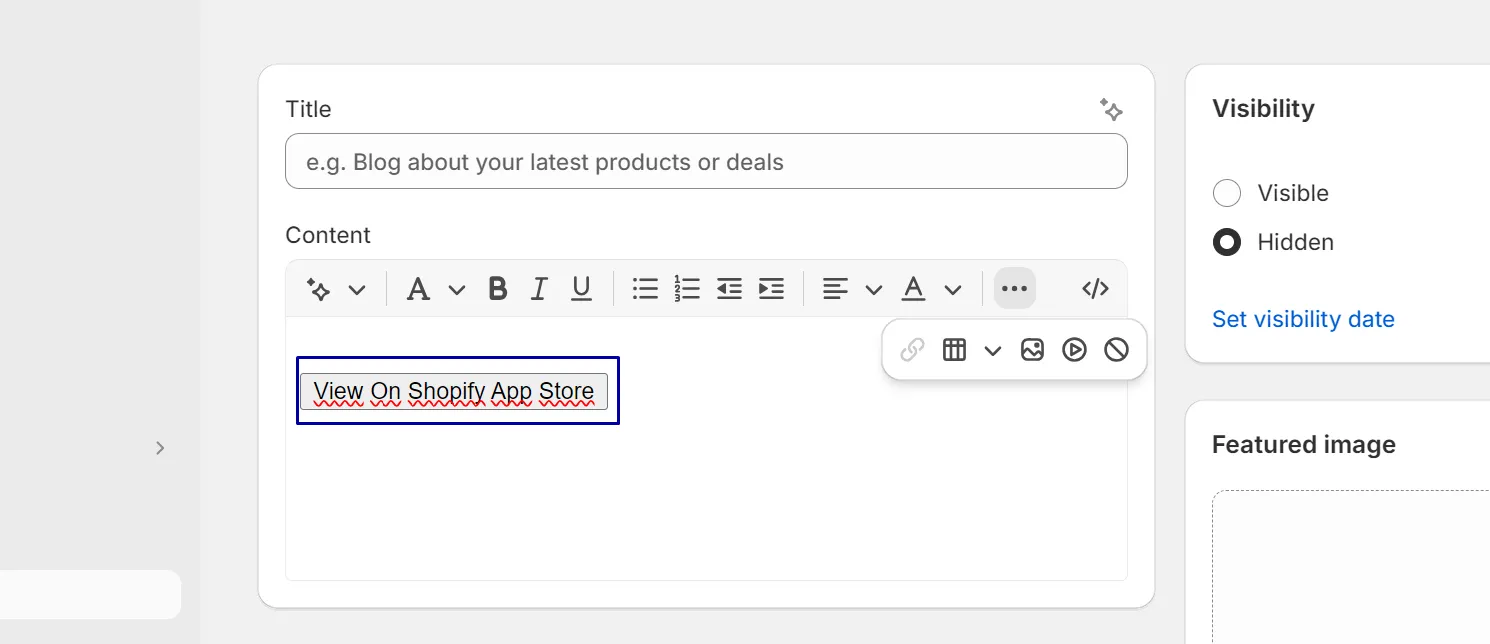
Step 6: Edit the Search Engine Listing for a Blog
The search engine listing preview section allows you to customize your article’s appearance in search engine results. Simply click “Edit website SEO” to refine your page titles, meta descriptions, and URLs, ensuring your content stands out.
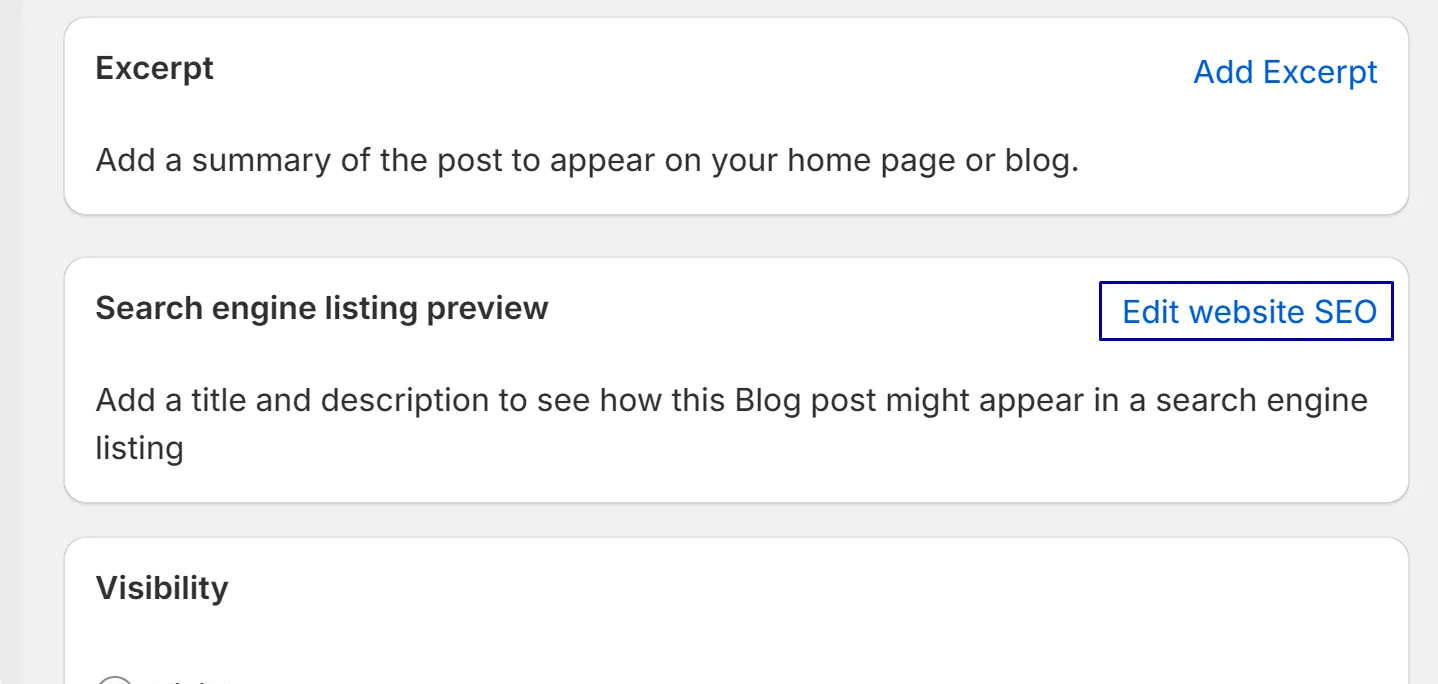
- Page title: Keep it under 70 characters to ensure it shows fully in search results. Clearly summarize your post using relevant keywords your target audience searches for.
- Description: Write a brief description (under 320 characters) summarizing your blog post’s main point. Incorporate relevant keywords to improve visibility in search engines. Moreover, you can consider adding a subtle call to action to entice users to click (e.g., “Learn how to…” or “Discover the secrets of…”)
- URL and handle: This is the web address of your blog post. Shopify automatically generates a URL based on your title, but you can customize it to make it more concise and keyword-rich.
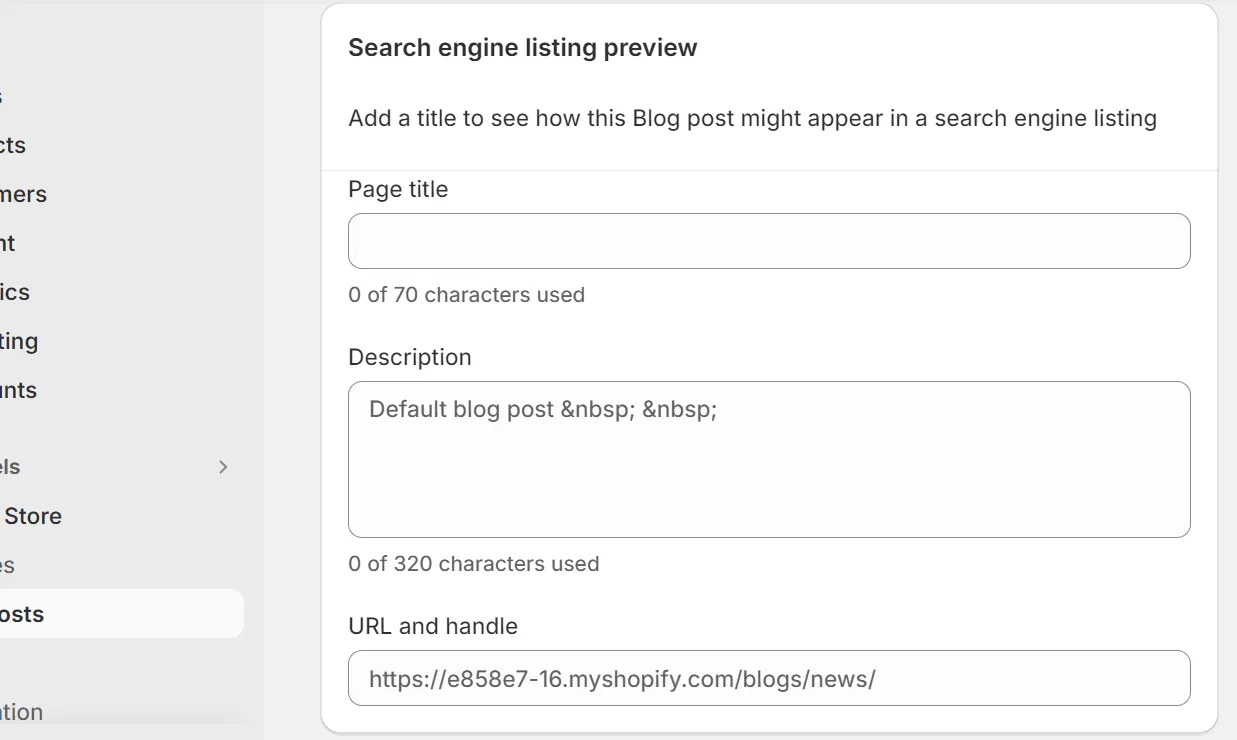
Step 7: Publish or Schedule your Blog
You can view your post by clicking the “View on your online store” link at the top and setting the blog to be visible right now or set it to be published at a later date.
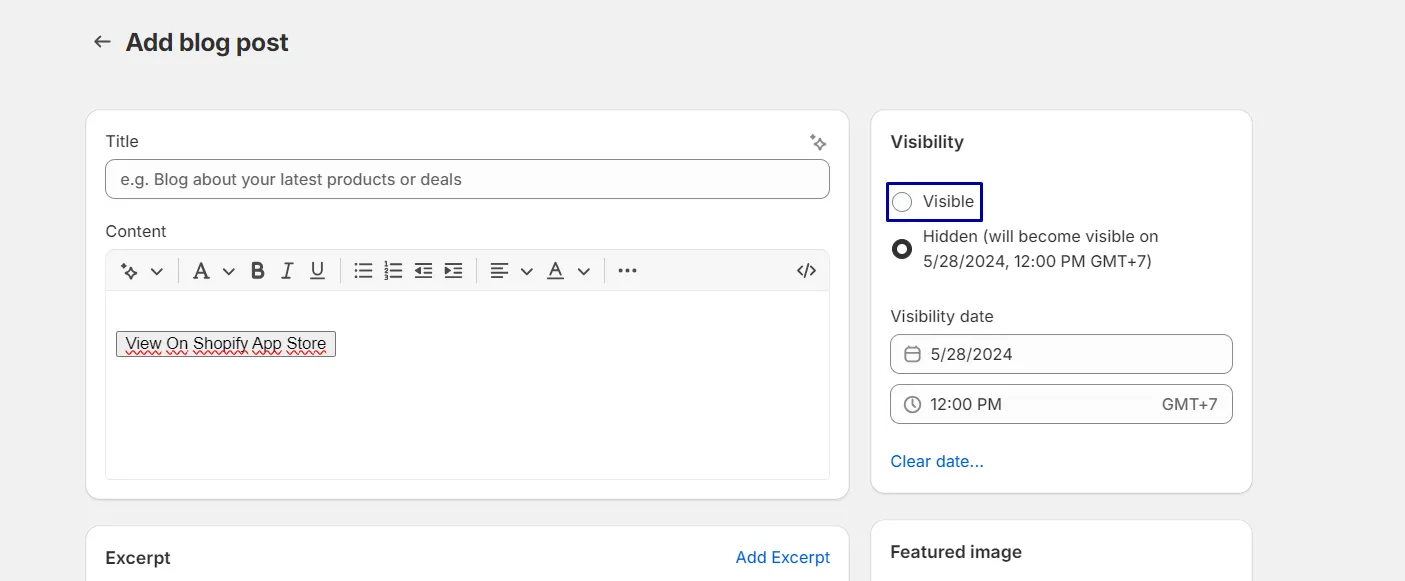
- After reviewing your blog article, click the “Save” button to create the blog.
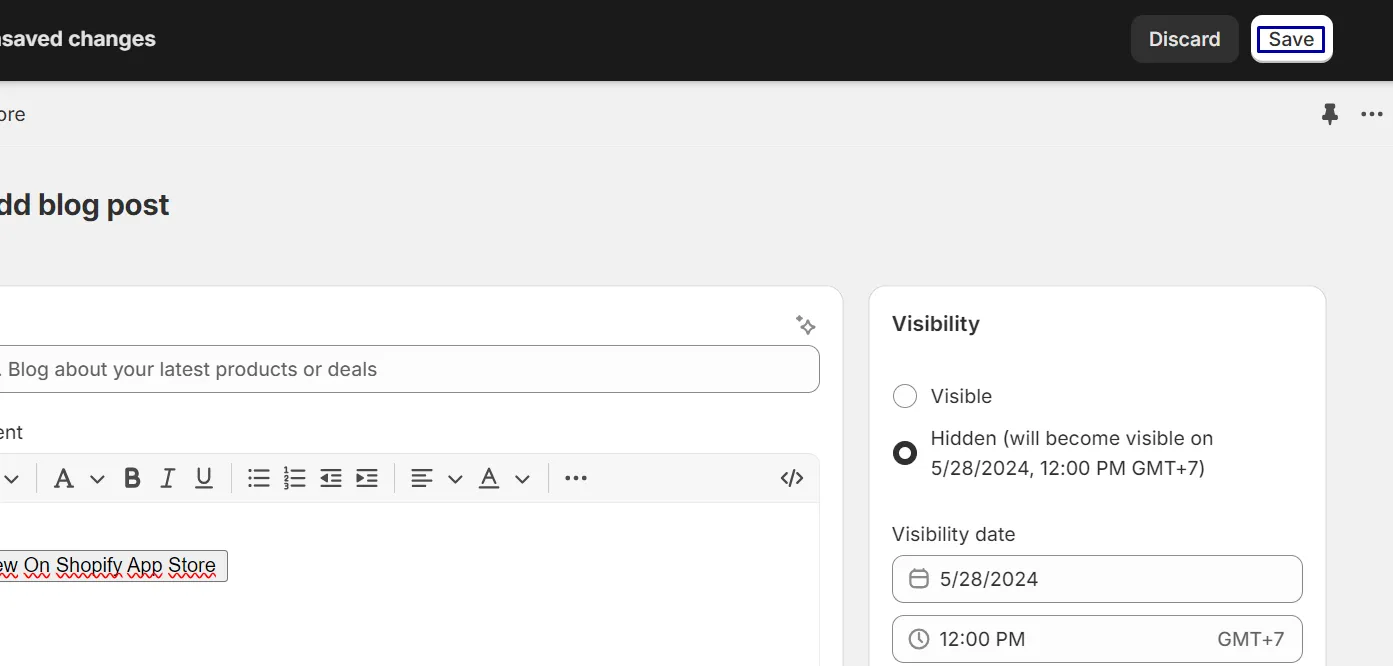
Step 8: Promote your Blog Post
Share your blog posts on platforms like Facebook, Twitter, Instagram, and LinkedIn to reach a wider audience. Use engaging captions and hashtags to increase visibility. Additionally, join relevant online communities and forums to share your content and engage with potential readers.
Top 5 Successful Shopify Blogs for Inspiration
Here are five successful Shopify blogs for inspiration, along with a breakdown of their unique features and content:
Blog 1: Nuun
Nuun’s blog caters to hydration enthusiasts, offering various topics, from hiking and exercise to nutrition and self-improvement.
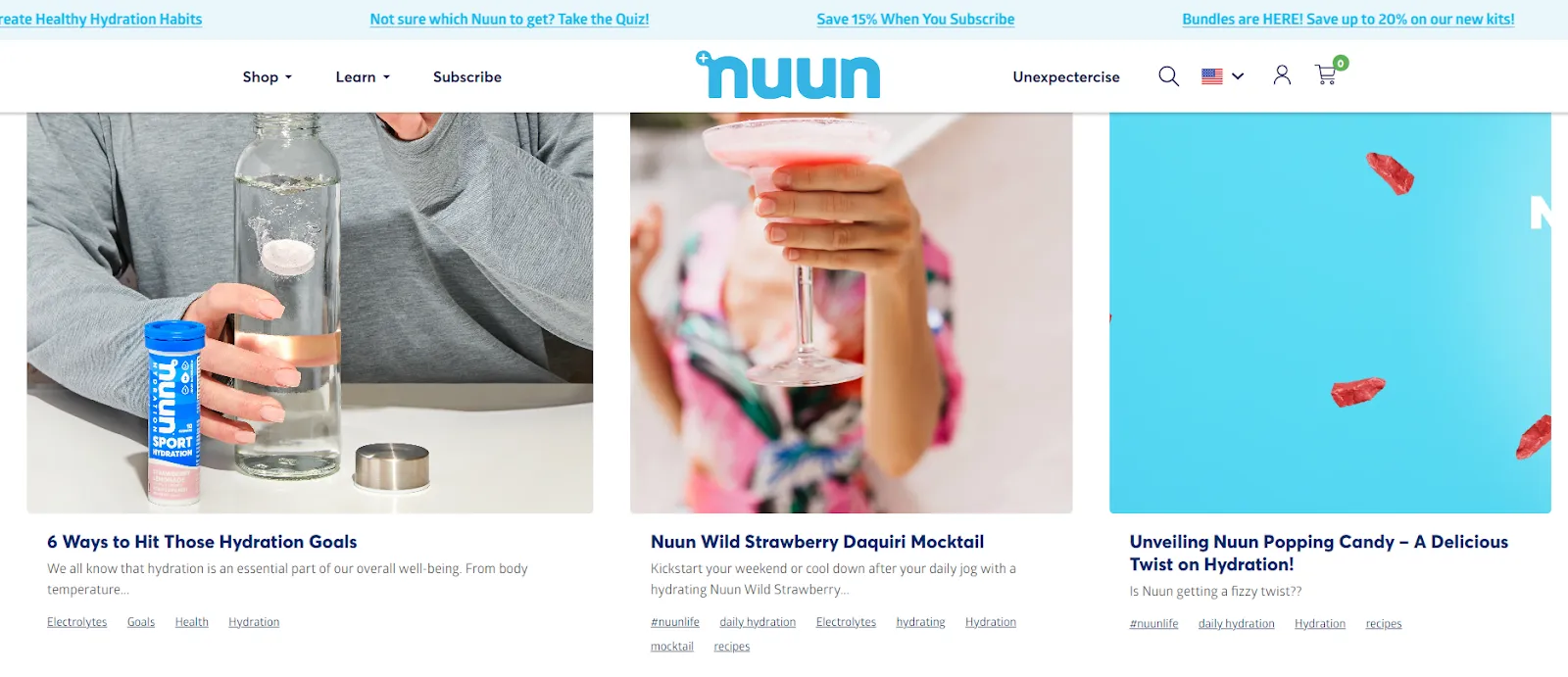
- Type of content: Informative articles, how-to guides, and interactive FAQs
- Content tone: Friendly, informative, engaging and health-conscious
- Content format: Blog posts, High-quality images, reels, and social media integration
- Frequency of content: Regular updates with fresh content.
What makes Nuun’s Blog stand out
- Visually Engaging: The blog uses full-width images and unique design elements to create an immersive and engaging reading experience.
- Interactive Content: Interactive FAQs add another layer of engagement, providing valuable information in an easily digestible format.
- Strategic SEO: The blog focuses on topics relevant to their products, attracting organic traffic and potential customers.
- Diverse Content: The blog covers a wide range of hydration-related topics, catering to a broad audience.
- Informative & Engaging: The content is well-researched, informative, and presented in an engaging and easy-to-understand manner.
Notable articles:
- The Health Benefits of Turmeric:
- How Does Dehydration Affect a Hangover?
- How Stress Affects Your Immune System
Blog 2: GymShark
Gymshark is a leading UK brand for fitness apparel and accessories. Their official blog is a go-to resource for fitness enthusiasts, providing informative articles while promoting their products. This strategy attracts many monthly visitors, demonstrating how Shopify merchants can use blogs to build a loyal following and drive sales.
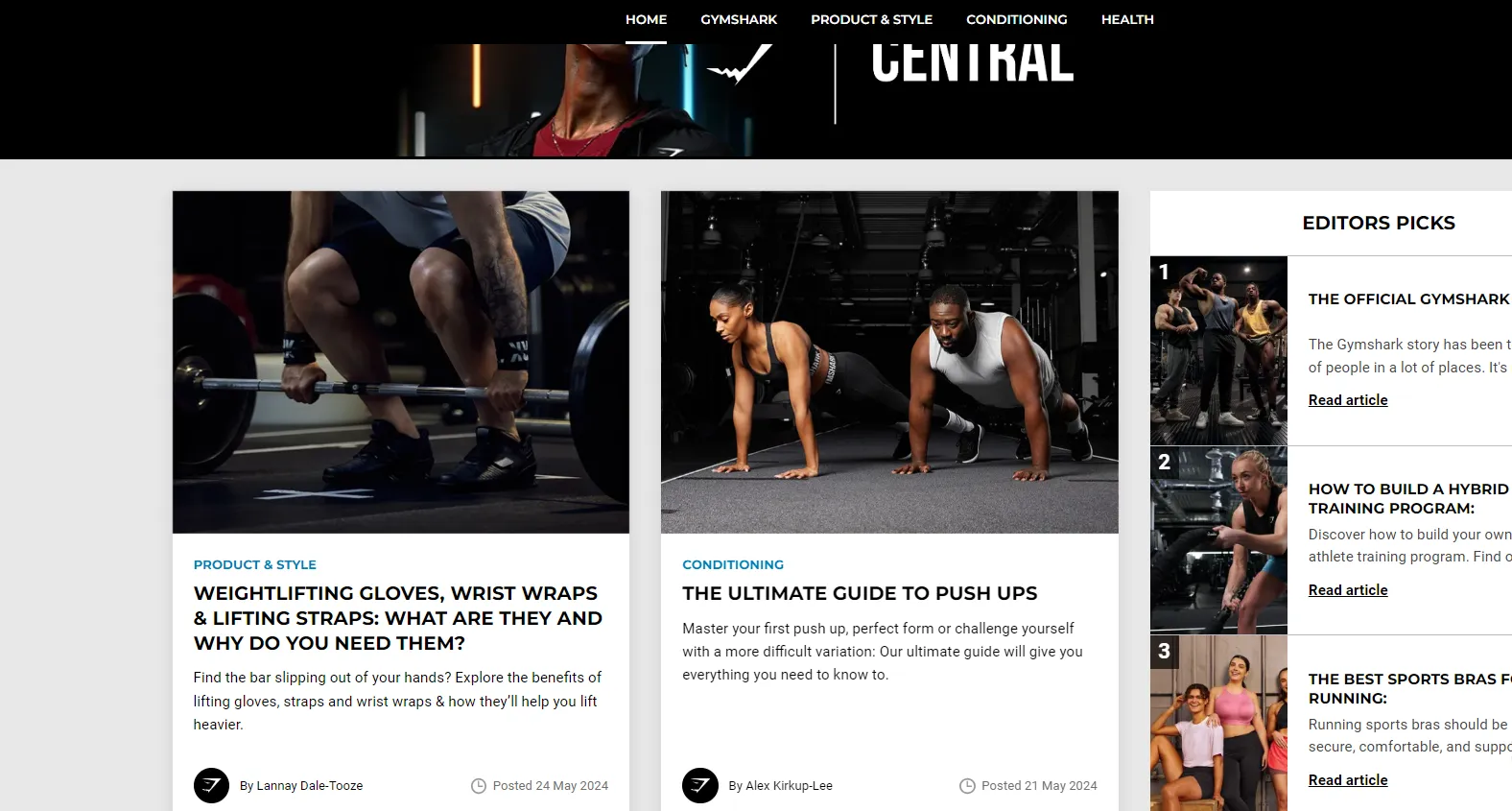
- Type of content: Workout routines, training tips from athletes, healthy recipes, or the lives of Gymshark ambassadors
- Content tone: Friendly, motivational, inspiring, and informative
- Content format: Blog posts, images, videos, short reels, and infographics
- Frequency of content: 2 - 3 blog posts/per week
What makes GymShark’s Blog stand out
- High-quality content: Offers a wide range of practical information (workout routines, fitness tips, or athlete profiles) that caters to their target audience.
- Product integration: Flexibly showcase their apparel and accessories in each blog post
- Community building: Craft user-friendly content and athlete stories, building a robust brand connection and driving sales
Notable articles:
- The Best Arm Exercises For Your Next Arm Workout
- The Best Trap Exercises To Build Big Traps
- The 6 Best Glute Exercises To Increase Strength And Size
Blog 3: Depology
Dēpology’s blog is a science-based resource that strategically answers common skincare questions their target audience searches for online.
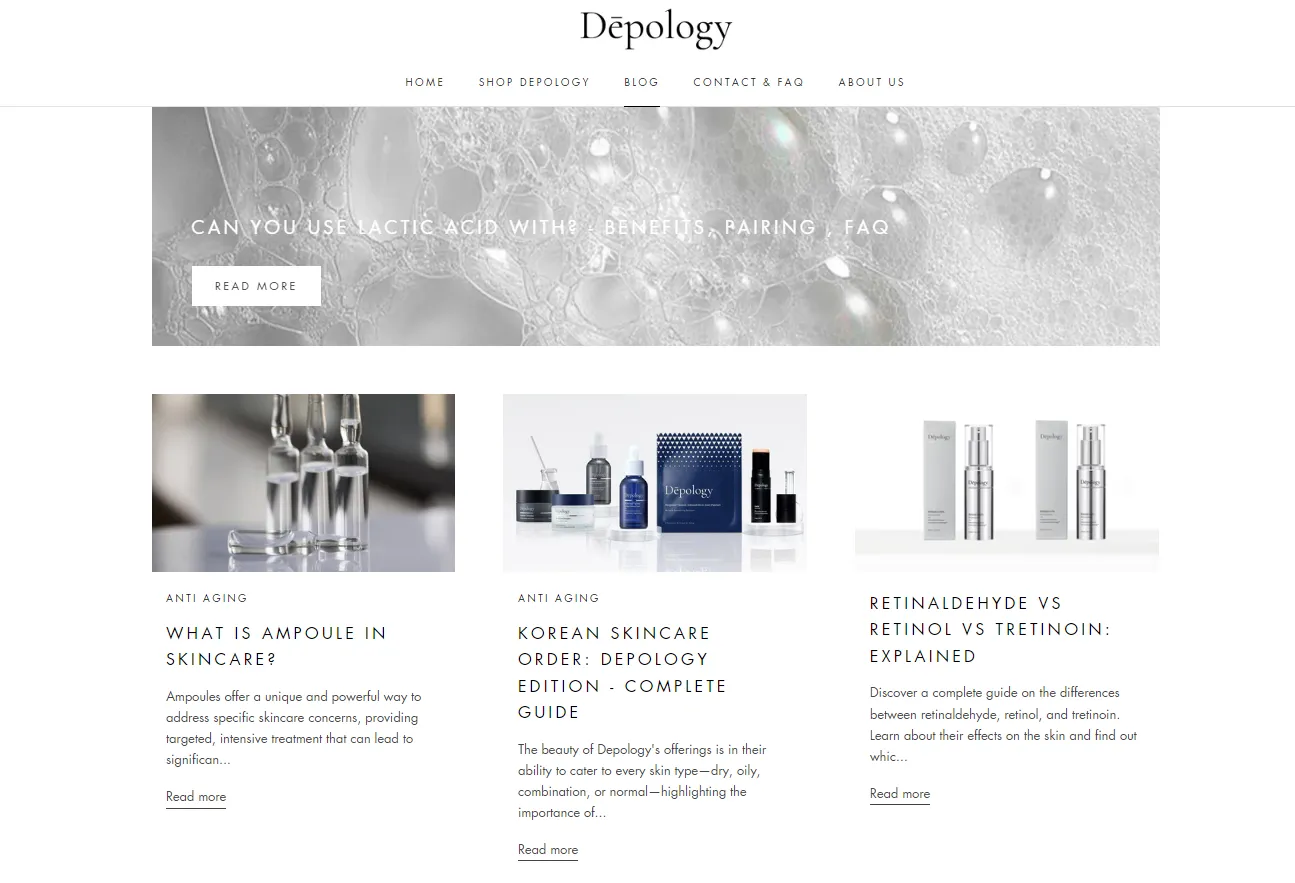
- Type of content: Skincare concerns & routines, tips & tricks, how-to guides, ingredients, and recipe menu
- Content tone: Clear, concise, informative, motivational, and promotional
- Content format: Blog posts, easy-to-read text, images, videos, reels, and infographics
- Frequency of content: 1 - 2 blog posts/day
What makes Dēpology’s Blog stand out
- SEO-Driven Strategy: The blog focuses on answering questions their audience is actively searching for, driving organic traffic to their website.
- Product-Led Answers: Content naturally leads to relevant product recommendations, increasing the likelihood of conversions.
- User-Friendly Design: Minimalist design prioritizes readability and quick access to information.
- Effective Product Integration: Depology’s product box element seamlessly incorporates product details and calls to action.
Notable articles:
- How To Use Under-eye Patches For Wrinkles And Puffiness
- Peptides For Men: Benefits, Types, And Side Effects
Blog 4: Beardband
Beardbrand’s blog is a shining example of how effective content marketing can drive e-commerce success. By focusing on high-quality, targeted content that resonates with its niche audience, Beardbrand has established itself as an authority in the men’s grooming industry.

- Type of content: Informational and educational articles, tips & tricks, how-to guides
- Content tone: Authoritative, informative, and engaging
- Content format: Blog posts, high-quality images, reels, and infographics
- Frequency of content: Not mentioned
What makes Beardbrand’s Blog stand out
- Targeted Content: They focus on topics that resonate with their ideal customer rather than trying to appeal to everyone.
- Tactical Keyword Selection: They strategically target high-value keywords to drive organic traffic and potential customers.
- Simple yet Effective Design: Their blog design is clean, organized, and easy to navigate, prioritizing user experience over flashy visuals.
Notable articles:
- The 23 Best Beard Styles For 2024
- How To Grow An Awesome Beard
- The Definitive Guide To Mustache Styles
Blog 5: Fashion Nova
Fashion Nova is a hit with trendy shoppers who love affordable clothes. They’re huge on social media, but their blog takes things a step further. Instead of just showing off their latest styles, they also talk about lifestyle topics, thus attracting more people and keeping their target audience engaged.
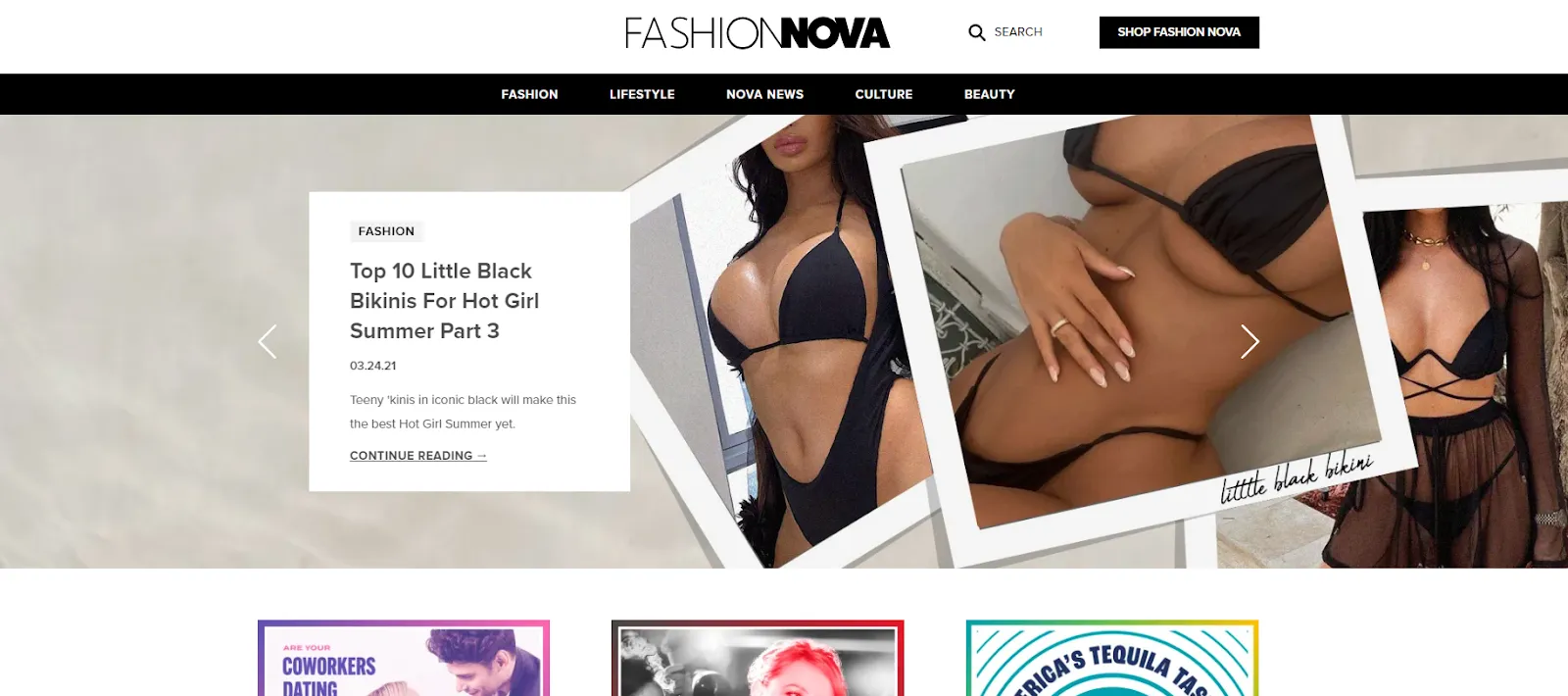
- Type of content: Outfit ideas, new arrivals, beauty tips, dating advice, or style trends
- Content tone: Youthful, trendy, motivational, conversational, and bold
- Content format: Articles, lists, how-to guides, high-quality images and videos
What makes Fashion Nova’s Blog stand out
- Cultural relevance: The blog stays on top of trends and pop culture, making it a hub for readers who want up-to-date information.
- Diverse Content: A wide range of topics keeps readers engaged and coming back for more, covering everything from fashion tips to lifestyle trends.
- Visually Appealing: Stunning photos and videos grab attention, showcasing their clothes effectively.
Notable article:
FAQs
Can you build a blog on Shopify?
Yes, Shopify offers a built-in blogging platform that allows you to create and manage a blog directly within your online store. Whether you want to share product updates, industry insights, or behind-the-scenes stories, Shopify provides a convenient way to connect with your audience and improve your brand’s online presence.
How to create a blog category in Shopify?
Creating a blog category in Shopify is a straightforward process:
- Step 1: Navigate to your Shopify admin dashboard and click “Online Store” then “Blog Posts.”
- Step 2: Select “Manage blogs.” Here, you choose an existing blog or create a new one
- Step 3: Click “Add Blog”. This is where you create your category, even though it says “blog.”
- Step 4: Enter a title for your category (e.g., “Recipes,” “News,” “Tutorials”).
- Step 5: Click the “Save” button to create a new blog/category.
Is blogging on Shopify worth it?
Yes, blogging on Shopify is worth it, especially if you run an online store. It allows you to integrate your blog with your ecommerce site, making it easy to promote your products.
Do Shopify blogs rank?
Yes, Shopify blogs can rank in search engine results. However, their success depends on several factors. Your blog posts need to be well-written, informative, and engaging. Moreover, you should optimize your content with relevant keywords and follow SEO best practices.
Final Thoughts
That’s how you can build a Shopify Blog. Building a blog on Shopify is a straightforward and rewarding process that can significantly improve your online store’s performance. Following the outlined steps and drawing inspiration from successful Shopify blogs, you can create a dynamic platform for engaging your audience, boosting SEO, and ultimately driving sales.
New Posts






